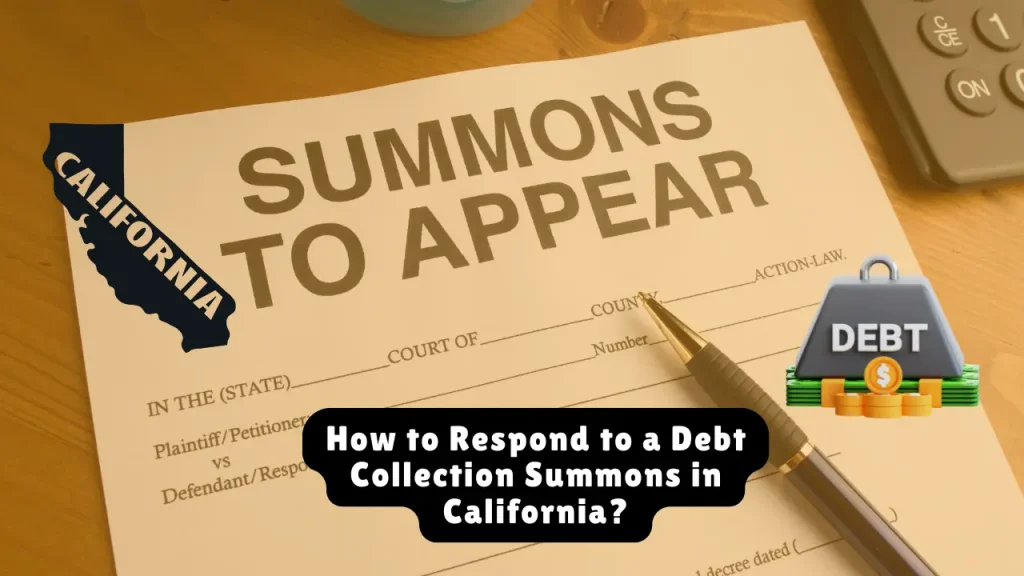How to Respond to a Debt Collection Summons in California?
Facing a debt collection lawsuit in California? You have a maximum of 30 days (or 40 in some cases) to respond—or risk a default judgment that enables wage garnishment, bank levies, and long-term credit damage. This definitive 2025 guide provides a step-by-step legal playbook to protect your rights, contest inaccurate claims, and strategically respond using proven legal tactics.
Default judgments account for 80% of creditor wins in California—because consumers fail to respond. Your answer alone can turn the tide.
— Upsolve Legal Review
Table of Contents
Step 1: Know Your Deadline and Service Type
Filing Deadline:
- 30 calendar days if personally served (includes weekends/holidays).
- 40 calendar days if served by:
- Substitute service (left with someone else at your residence or workplace).
- First-class mail.
- Old or incorrect address.
- Substitute service (left with someone else at your residence or workplace).
Missed the deadline? Immediately call the court clerk to check if a default judgment has been entered. If not, you may still file an Answer.
Step 2: Review the Summons and Complaint Carefully
Thoroughly inspect the court documents served to you:
- Check who is suing you (original creditor vs. third-party debt buyer).
- Verify the debt amount, interest charges, and dates of transactions.
- Look for numbered allegations—you must respond to each in your Answer.
- Note licensing details: Debt buyers in California must list a license from the CA Department of Financial Protection & Innovation.
🛑 60% of sold debts contain errors. Always validate details like account numbers, balance, and creditor names.
Step 3: Draft Your Answer Using Form PLD-C-010
Required Form:
- PLD‑C‑010: Answer – Contract
Download from California Courts
A. Respond to Allegations
You must respond to each numbered paragraph in one of three ways:
- Admit – Only if completely accurate.
- Deny – Common choice to contest the claim.
- Deny for lack of information – If you’re unsure about the truth of the statement.
Pro Tip: If the complaint is unverified, you can check the “General Denial” box.
B. Assert Affirmative Defenses (Attachment 4)
Failure to raise these now means you forfeit them later. Common defenses include:
| Defense | Required Evidence | Success Rate |
| Statute of limitations | Last payment or account activity date | 85% |
| Improper service | Server’s declaration of service attempts | 40% |
| Identity theft | Police report, FTC affidavit | 75% |
| Paid debt already | Bank records, receipts | Varies |
| Collector lacks standing | Missing chain-of-title documentation | 60% |
Statute of Limitations:
- 4 years for oral contracts.
- 6 years for written contracts/credit cards in California.
C. Include Additional Forms (If Applicable)
- Verification (if debt is >$25,000 and complaint is verified).
- Fee Waiver (FW‑001 & FW‑003): If income ≤ $1,436/month or you receive public benefits.
Related article: How to Answer a Summons for Debt Collection?

Step 4: Serve and File the Answer
Filing:
- Print three copies of your completed Answer packet.
- File the original and two copies with the court listed on the summons.
- Pay filing fee:
- $225 (if debt ≤ $10,000),
- $370 ($10K–$25K),
- $435 (> $25K).
- $225 (if debt ≤ $10,000),
Need fee relief? File FW‑001 and FW‑003 for a potential full waiver.
Serving the Plaintiff:
- Have someone 18+ (not you) mail a copy of the Answer to the plaintiff’s attorney.
- Use regular first-class mail only (not certified or personal delivery).
- Complete Proof of Service (POS‑030):
- Must be filled out and signed by the server.
- Attach this form to your court-filed Answer.
- Must be filled out and signed by the server.
Step 5: Avoid These Common Mistakes
- Never ignore discovery: Timely respond to Interrogatories or Requests for Admission.
- Don’t admit partial guilt: Phrases like “I’ll pay later” reset the statute of limitations.
- Don’t serve documents yourself: Only a third-party adult can serve.
Post-Answer Strategies: From Defense to Offense
A. Consider Settlement
Filing an Answer increases your leverage to negotiate:
- Offer 30–60% lump sum settlements post-Answer to avoid trial.
- Use this script:
“I’ll pay $X if you dismiss the case with prejudice and remove negative credit reporting.” - Get it in writing: Require a filed Request for Dismissal (Form CIV‑110).
B. Use Legal Tactics
- Motion to Compel Arbitration: If original contract had an arbitration clause, this may force the case out of court.
- Demand documentation: Most debt buyers lack original signed agreements—use this to your advantage.
C. Consider Bankruptcy (If Applicable)
- Chapter 7 bankruptcy: Stops lawsuits and discharges qualifying debts in 3–4 months.
- Chapter 13 bankruptcy: Creates structured repayment plan.
Missed the Deadline? Motion to Vacate Default
If a default judgment was entered against you, file a Motion to Vacate under California Code of Civil Procedure §473. Valid reasons include:
- Improper service.
- Serious illness or disability.
- Lack of notice.
Prompt action is critical to reopen your case.
California-Specific Resources & Templates
| Tool | Purpose | Link |
| PLD‑C‑010 | Answer form | Download |
| FW‑001, FW‑003 | Fee waiver | Download |
| POS‑030 | Proof of service | Download |
| CIV‑110 | Request for Dismissal | Download |
| SoloSuit | Automated Answer preparation | Up to $199 with legal review |
| LawHelpCA.org | Free legal aid statewide | Legal clinics & self-help |
When to Consult a Lawyer
Hire a consumer rights attorney if:
- The debt exceeds $10,000.
- You’re facing wage garnishment or property liens.
- Creditors violated the FDCPA, which may entitle you to $1,000 + legal fees.
Affordable options:
- Legal Aid Foundation of Los Angeles (LAFLA): (800) 399‑4529.
- SoloSuit: Legal review of Answers for a fraction of full representation costs.
Final Takeaways: Your Legal Roadmap
- Act fast: File your Answer within 30–40 days.
- Deny strategically: Force the creditor to prove their claims.
- Leverage the law: Use affirmative defenses and demand evidence.
- Negotiate from strength: Settlement becomes possible once you respond.
- Stay vigilant: Respond to discovery and watch for procedural errors.
“Debt collectors win by default, not merit. Make them earn it—respond properly.”
— California Consumer Legal Defense Network
About the Author

Sarah Klein, JD, is a former consumer rights attorney who spent years helping clients with issues like unfair billing, product disputes, and debt collection practices. At All About Lawyer, she simplifies consumer protection laws so readers can defend their rights and resolve problems with confidence.
Read more about Sarah
